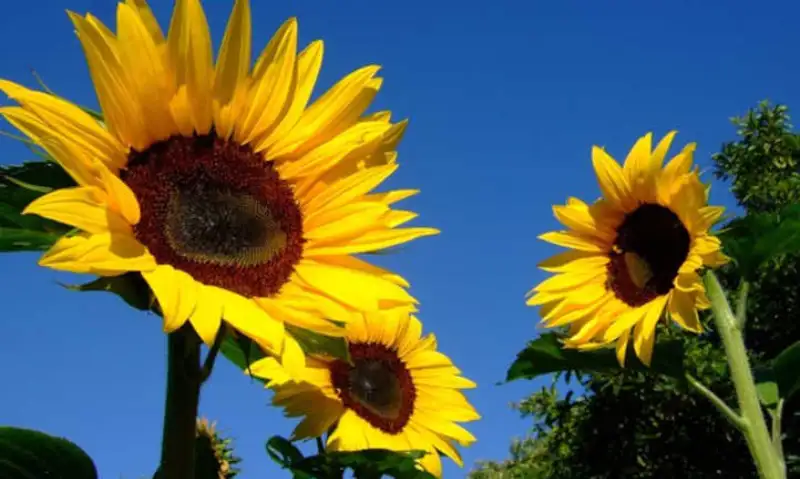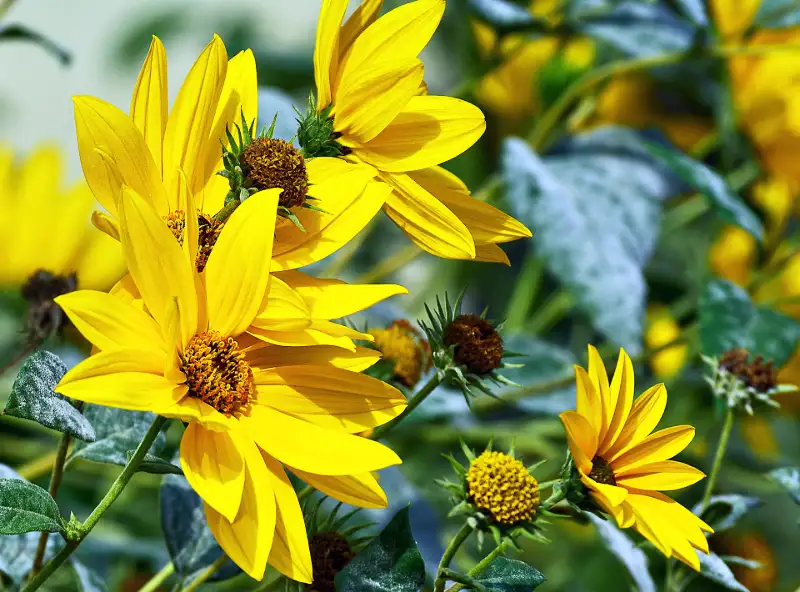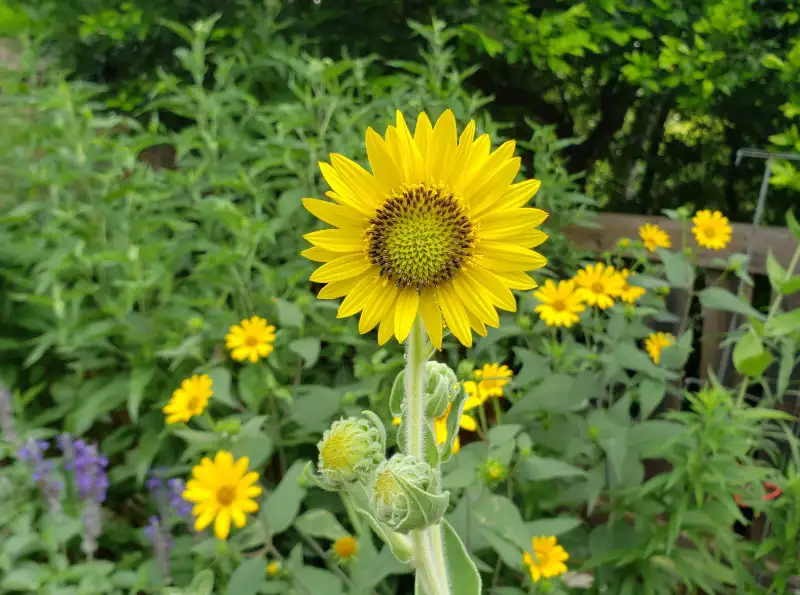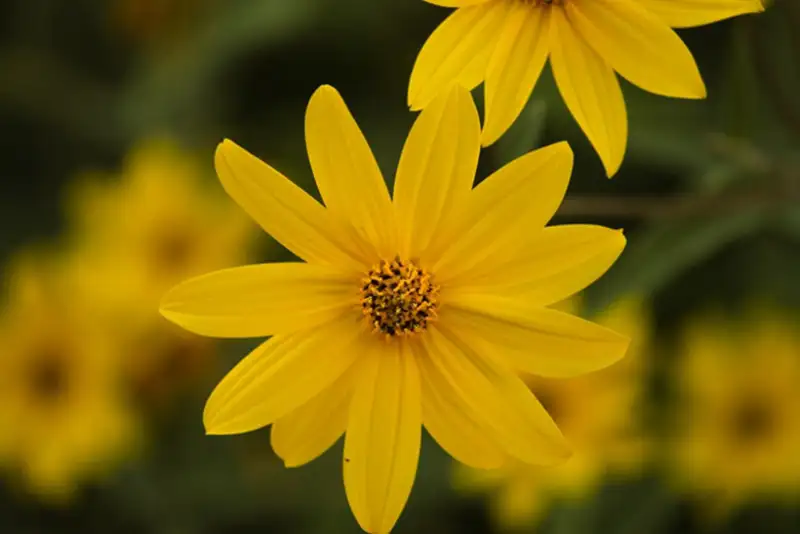Are you eager to learn about perennial sunflowers?
This article will delve into the BENEFITS of growing perennial sunflowers. Offering you an in-depth GUIDE about different TYPES of perennial plants.
Plus, how to care for these VIBRANT perennials that bring joy year after year.
So, TRUST US as your ULTIMATE resource for all things perennial sunflower species.
Our EXPERT ADVICE and GARDENING TIPS help you to cultivate a stunning, vibrant garden.
So let us GUIDE you to a victorious GARDENING EXPERIENCE with the most perennial sunflowers.
Discover the BEAUTY and BENEFITS of different perennial varieties with our COMPREHENSIVE guide.
EMPOWERING you with the EXPERTISE needed to cultivate a stunning and thriving garden.

Introduction of Perennial Sunflowers

Annual sunflowers require replanting each year. Still, they are EXTREMELY EASY to grow from seeds.
The case is quite the OPPOSITE in the case of perennial sunflowers. They have the POTENTIAL to come back every year, REGENERATING from their strong roots.
Isn’t that awesome? But wait, there’s more!
These STUNNING flowers BOAST a lengthy blooming period.
Thus GRACE your VEGETABLE garden with its beauty from late summer through mid-autumn.
These species add a MAJESTIC TOUCH and APPEALING VIEW because of the:
- Tall stems
- Large flowers
- Attractive foliage
COOL, Right?
They also provide NECTAR and POLLEN to the pollinators.
Apart from their ORNAMENTAL CHARM, perennial sunflowers demand MINIMAL upkeep once ESTABLISHED.
Thus, providing various BENEFITS to both the gardeners and the environment.
Benefits of Growing Perennial Sunflowers

Growing perennial sunflowers can be a gratifying addition to every garden. These tall and vibrant flowers are known for their stunning display.
Perennial sunflowers OFFER plenty of benefits when growing.
The most beneficial once INCLUDE the following:
Vibrant Blooms
Perennial sunflowers come in DIFFERENT shades, adding NATURAL BEAUTY to your garden.
Want to know how awesome this is?
LISTEN! These vibrant flowers ADD BEAUTY to any area where they are planted.
Thus, it creates a bright and visually appealing display.
Perennial Sunflowers Are Edible
Perennial sunflower varieties yield EDIBLE tubers.
It means the seeds can be HARVESTED and used for culinary purposes or as a food source for WILDLIFE.
Because seeds are high in proteins and healthy fats, they can also be UTILIZED to produce oil.
These make them a SIGNIFICANT addition to any garden.
The YOUNG GREEN shoots of tall perennials are also full of NUTRIENTS and TASTE.
I really RECOMMEND you try it once.
HARVEST the shoot during early spring and enjoy either raw or processed as a culinary option.
Low Maintenance
I have FELT that perennial sunflowers require MINIMAL upkeep once rooted firmly.
They are WELL-ADAPTED to their local environment and can TOLERATE different conditions.
Cool, right?
Sunflowers have natural RESISTANCE to pests and diseases. This CHARACTER will MINIMIZE your reliance on chemical pesticides or herbicides.
Improve Soil Health
Perennial sunflowers feature a robust and deeply PENETRATING ROOT SYSTEM. This system CONTRIBUTES to the ENRICHMENT of soil health.
This EXTENSIVE root system can actually help to:
- Improve soil structure
- Increase organic matter content
- Improves the nutrient cycle, which benefits the garden’s overall health.
Erosion Control
The DEEP root system of sunflowers helps STABILIZE soil and REDUCE soil erosion.
Due to this reason, many gardeners OPT to GROW them on slopes. It is because it HELPS to regulate water flow and capture essential nutrients.
The tall stems and ABUNDANT leaves provide a NATURAL BARRIER against water erosion.
Thus it helps to PROTECT the soil and prevent nutrient RUNOFF.
Suggested reading: 16 Popular Small Perennial Flowers For Low Maintenance Garden
Care Tips for Perennial Sunflower

Caring for perennial sunflowers is RELATIVELY straightforward because they require MINIMAL MAINTENANCE. It means you can enjoy their beauty with a LITTLE effort.
These are the hardy-plant, well-adapted to a VARIETY of growing conditions.
It is still NECESSARY to take good care of them.
Here are some CARING TIPS to ensure the health and vitality of perennial sunflowers:
Planting
Perennial sunflowers LOVE warm and SHELTERED SPOTS. They also FEEL HOMELY in nutrient-rich and well-drained soil conditions.
GETTING my point?
Based on their species, sunflowers EXHIBIT different moisture INCLINATIONS.
Some THRIVE in dry soil, while others prefer fresh to moderately moist soil.
With that said, I HOPE you GOT that where to plant your perennial sunflowers.
Don’t you?
Selecting a well-draining spot with AMPLE sunlight is BEST for these MAJESTIC flowers.
Because choosing a DARK LOCATION for planting sunflowers RESULTS in fewer flowers.
Watering And Fertilizing
Perennial sunflowers are QUITE drought-tolerant; you should not let them DRY OUT.
MAINTAIN a regular watering schedule for your perennial sunflowers. Water them more CONSISTENTLY during the period of heat and drought.
But MAKE SURE to prevent the plant from getting wet.
GET THIS?
These flowering plants prefer EVENLY MOIST soil but TOLERATE short periods of DRYNESS.
Like watering, perennial sunflowers generally DO NOT REQUIRE heavy fertilization.
LISTEN! They can TOLERATE nutrient-poor soils.
Therefore, fertilizing with nutrient-rich fertilizer has a NEGATIVE IMPACT on flowering.
However, you can apply BALANCED fertilizer during the growing season for HEALTHY growth.
Staking
Several CULTIVARS of perennials need staking to PREVENT TOPPLING in winds and rainfall.
But how can you do so?
Use bamboo stakes or other SUPPORT to help retain the stem UPRIGHT and prevent it from breaking.
Winter Care
Perennial sunflowers are hardy and can SURVIVE in winter.
But PROVIDING some winter care helps PROTECT them from ADVERSE weather conditions.
GET THIS?
The base of the plant can be insulated by a layer of MULCH in colder climates.
Isn’t that awesome?
Leave the stems STANDING through the winter, as they provide WINTER INTEREST.
7 Types of Perennial Sunflower
These hardy plants offer a range of options for gardening enthusiasts.
So, when SELECTING sunflower varieties, be sure to choose the PERFECT OPTIONS.
It is crucial to CREATE a land that is both stunning and enduring.
Now, it’s time to DISCUSS seven different KINDS of perennial sunflowers.
1. Maximilian Sunflower

Prairie or Maximilian sunflower is a MAGNIFICENT addition to any garden.
Standing tall, they are PROLIFIC BLOOMERS and INCREDIBLY EASY to grow from seeds.
One of their REMARKABLE qualities is their ABILITY to reseed freely.
In addition to their self-seeding prowess, Maximilian sunflowers are EFFICIENT at NEUTRALIZING.
Though paler than most perennials, their vibrant yellow petals create a STUNNING DISPLAY. This display attracts late-season birds and butterflies.
Maximilian sunflowers are very easy to grow.
But what type of conditions can it tolerate?
LISTEN! It is TOLERANT to drought conditions. Thus it can FLOURISH in VARIOUS HARSH ENVIRONMENTS.
Like it thrives from arid to moist soils, and from clay to sandy soils.
These ATTRIBUTES make it a FANTASTIC choice for numerous gardens.
- Scientific Name: Helianthus maximiliani
- Hardiness Zone: 4-9
- Size: 3-10 feet tall. But it may depend on the moisture level.
- Blooming Season: Maximilian flowers bloom in late summer and last until fall.
2. Ashy Sunflower

The MONIKER ‘Ashy’ originates from the silvery hue of the foliage, resulting from MINUSCULE HAIRS.
Cool, right?
These COMPACT ashy sunflowers have ROUNDED petal edges.
Their foliage is light green with HAIRY stems and leaves. On the other hand, there are vibrant flowers that are yellowish in color and have GOLDEN centers.
Ashy sunflower is one of the EASIEST perennials to grow, so I RECOMMEND it to anyone who is a BEGINNER.
This long-blooming VARIETY does SOUND in well-drained soil and full sun, including:
- Sand
- Chalk
- Gravel
The nutritious seeds of this plant are a FAVORITE among birds, particularly goldfinches.
It is HIGHLY SUITABLE for COLONY FARMING, as it EASILY NATURALIZES. Moreover, it has the CAPACITY to SPREAD in an area through both rhizomes and seeds.
- Scientific Name: Helianthus mollis Lam
- Hardiness Zone: Ashy sunflowers are hardy in zones 4 to 9.
- Size: These perennial sunflowers grow about 2-4 feet tall.
- Blooming Season: Bloom in late summer and last until fall.
3. Western Sunflower

Western sunflowers are often STATED as ‘few-leaf sunflowers.’ It is due to the SCARCITY of leaves on their stalks.
LISTEN! LISTEN! Birds and butterflies LOVE western sunflowers.
This CHEERY sunflower is a GOOD CHOICE for borders SINCE the clusters don’t SPREAD.
Get this?
Let me tell you about the requirements it needs to thrive.
It is highly EFFECTIVE at stabilizing soil.
It also PERFORMS well in a variety of soil types, including rocky and sandy soils in full sunlight.
However, the vegetation that forms clusters exhibit reduced resilience to compacted clay soil.
- Scientific Name: Helianthus occidentalis
- Hardiness Zone: The USDA hardiness zones of western sunflower is between 3-9
- Size: Western sunflower grows 2-3 feet tall.
- Blooming Season: The bright yellow blooms appear in late summer and last until fall.
4. Jerusalem Artichoke

Jerusalem artichokes are a GREAT PART of food forests and permaculture circles.
That leads the gardeners to grow these sunflowers widely as a perennial VEGETABLES.
Listen! Jerusalem artichoke has a NUTRITIOUS ROOT that can be cooked as a vegetable. Thus it is CONSIDERED an ESSENTIAL food crop to permaculture enthusiasts.
I have observed that this food producing plant is quite meddlesome.
But they require LOW MAINTENANCE and thrive in both moist and well-draining soils.
The VERSATILITY of Helianthus tuberosus is virtually LIMITLESS. That versatility makes it an exceptional option for a wildflower and cut-flower gardens.
In fact, it may be the sole perennial variety suitable for backyard cultivation!
- Scientific Name: Helianthus tuberosus
- Hardiness Zone: 3-9
- Size: Jerusalem artichokes grow between 6 to 10 feet tall.
- Blooming Season: Jerusalem Artichoke bloom from mid-summer through fall.
5. Willowleaf Sunflower

Willow leaf sunflower is a STRIKING perennial plant that can be an eye-catcher in any garden.
The leaves are TYPICALLY dark green, adding an elegant and feathery texture to the garden.
The plant also produces plenty of bright yellow flowers, adding to its visual appeal.
It tends as it is INDIGENOUS to limestone prairies, it has the tendency to spread AGGRESSIVELY.
Thus, once established it PREFERS well-draining soil with full sun.
It can be a low-maintenance ADDITION to the garden, REQUIRING minimal care.
Here is how it gets its name.
The willow-leaf sunflower is KNOWN for its slender, lance-shaped leaves. These leaves are RESEMBLE willow leaves, hence their name.
As a gardening expert, I VOUCH for the captivating traits of this sunflower species.
- Scientific Name: (Helianthus salicifolius)
- Hardiness Zone: The USDA hardiness zones for this variety are between 4-9
- Size: Willow leaf sunflower has an impressive height. It often reaches 10 feet or taller, making it a commanding presence in the garden.
- Blooming Season: Blooms in late summer or early fall.
6. Beach Sunflower

Beach sunflower, also called cucumber leaf sunflower and east coast dune sunflower.
This CLUMPING variety is tolerant to POOR SOIL but is not cold-tolerant. Its shorter HEIGHT and spreading growth make it a CHARMING GROUND COVER OPTION.
THANKS to their HIGH SALT TOLERANCE. Because this feature makes it PARTICULARLY IDEAL for coastal gardens.
Their abundant greenery cascades along the soil through runners, even in such circumstances.
- Scientific Name: (Helianthus debilis)
- Hardiness Zone: 8-10
- Size: Beach sunflowers with bright yellow blooms are 1-3 feet tall.
- Blooming Season: Beach sunflowers blooms from spring through fall.
7. Thin-leaved Sunflower

These are HYBRIDS with double-pleated flowers.
Believed a CROSS between annual sunflower and a perennial species “Helianthus decapetalus.”
Get this?
It has NUMEROUS cultivars, including:
- Loddon Gold
- Sunshine Daydream
- Capenoch Star
All these grow to a HEIGHT of 6 feet, 5 feet, and 4 feet, respectively, with butterscotch yellow petals and centers.
The blooms are ‘pom-pom’ like and favor woodland and edges.
And what about its surviving conditions?
WELL! I have OBSERVED that this variety is LENIENT to high humidity and doesn’t need staking.
- Scientific Name: (Helianthus angustifolius)
- Hardiness Zone: 4-8
- Size: Grows up to 4-6 feet in height.
- Blooming Season: Blooms in early summer to late fall.
FAQs about Perennial Sunflower
1. How do I know if my sunflower is annual or perennial?
Annual sunflowers GO THROUGH their life cycle within a single cultivation season.
IN CONTRAST, perennials won’t DEVELOP blooms until the second year. Since perennials will come back year after year, REGROWING from their roots.
OBSERVE over MULTIPLE growing seasons, in order to determine your sunflower’s type.
If the plant DIES after producing seeds and doesn’t regrow, it is likely an annual sunflower.
But if it grows from the SAME ROOT SYSTEM and produces flowers again, it is a perennial flower.
2. What month do you plant sunflowers?
Sunflowers are TYPICALLY planted in the spring when the last frost has PASSED.
So, the IDEAL time to plant sunflowers generally FALLS between April and May.
It is CRUCIAL to consider the local weather conditions and soil temperature. It is because sunflowers demand warm soil conditions for germination and growth.
3. What not to plant with sunflowers?
Sunflowers are generally COMPATIBLE with other plants. Still there are some plants that aren’t RECOMMENDED to plant with sunflowers.
It is because they both can COMPETE for nutrients in the soil.
Some plants to AVOID planting with sunflowers include:
· Potatoes
· Beans
· Tomatoes
Also, avoid plantin
4. Can you grow perennial sunflowers in pots?
Although, sunflowers can take up A LOT OF ROOM in the garden. But wide, compact, container-friendly varieties are AVAILABLE to plant in pots.
Consider the SPECIFIC REQUIREMENTS of perennial sunflowers, like:
· Select a spacious container with ADEQUATE DRAINAGE.
· Utilize a WELL-DRAINING potting mix.
· Place the pot in a sunny location.
· Water regularly.
What’s Next
You have got SO MANY details about perennial sunflowers.
Perennial sunflowers REGROW from their roots and COME BACK to the garden year after year.
These are hardy and low-maintenance plants, but taking GOOD CARE of them is crucial.
Just choose a PERFECT VARIETY if you plan to plant sunflowers.
That’s all for today.
If you are willing to LEARN more about plants must visit, AsterGardening.
I ASSURE you that HERE you will get EXPERT GUIDES about all the plants.
So, if you have any PROBLEMS, reach out to us.
